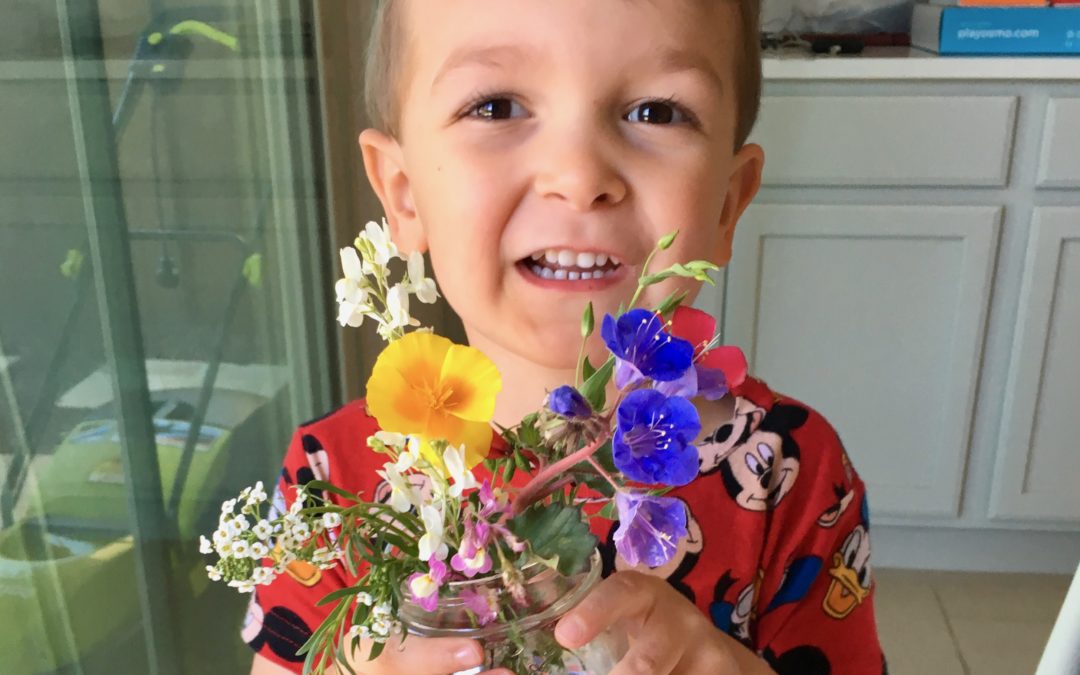At Phoenix Modern, a significant portion of our weekly schedule is developed to quests: multi-week, interdisciplinary projects that culminate in a student-run exhibition. We approach our quest design using an “emergent curriculum approach.” An emergent curriculum is a curriculum that “emerges” from children’s interests and curiosities. The guide begins with broad topics that are aligned to Arizona’s state standards and develops an initial set of learning experiences. As children engage with these experiences, the guide steps into the role of researcher, investigator, and facilitator. The guide captures and documents learning and organically builds additional learning experiences based on what she hears students thinking, saying, and doing.
Consider the following scenario of a quest, where children in the Elementary Studio have demonstrated an interest in animals that are native to Arizona (NGSS 3-LS4-3). A guide documents the following conversation between students who are reading about animals whose habitat is the desert:
Student 1: Coyotes live in the desert. That’s their habitat. I know because I saw a coyote one time and my dad told me they live in the desert.
Student 2: Sometimes there are coyotes in my neighborhood. Is a neighborhood a habitat?
Student 3: We saw a coyote in my neighborhood too.
Student 1: So some coyotes live in the desert and some coyotes live in neighborhoods. Can coyotes have two habitats?
The guide asks students which habitat they think is better suited to a coyote’s needs (AZ.SS.3.G4.1).
Student 3: Well my mom doesn’t like coyotes. She said that they can eat dogs. When there was a coyote in our neighborhood, she called the police to come get it.
Student 2: The police? To arrest the coyote?
Student 3: No. To take it away and put it somewhere else.
Student 1: They probably brought it to the desert. That’s where the coyote would want to be. There are too many cars in neighborhoods. And too many dogs.
Student 2: So if coyotes like the desert better, why do they live in neighborhoods too?
Student 1: Well some neighborhoods are in the desert. Like my house is next to a mountain [preserve]. So maybe the coyotes just get lost and end up in neighborhoods.
This guide knows which preserve Student 1 is referring to. That evening, the guide reaches out to a park ranger at this preserve to see if he would be willing to Skype with the class that week. The students are so excited to speak with the park ranger, who teaches them about other animals native to the desert. He also extends an invitation for them to stop by the ranger station at any time.
During Writer’s Workshop (class time devoted to writing production) the guide suggests that students co-create a story (AZ.3.W.3) about a lost coyote trying to find its way back to the desert. The students decide to dramatize their story and turn it into a play that they will perform for their exhibition (AZ.3.RF.4). The students research how to put on a play and quickly realize that they will have to build a set. The guide plans a field trip to a mountain preserve so that students can observe and investigate the desert in order to design their sets for the play (NGSS.3.PS2.2). At the preserve, the students stop by the ranger station to meet the park ranger they’d Skyped with two weeks prior.
The students return to the classroom and decide to conduct additional research about coyote habitats (AZ.3.RI.1, AZ.3.W.7). While conducting their research, students come across a nonprofit that raises money to protect coyotes. The guide documents the following conversation:
Student 3: Look! I found this website. It’s these people who help coyotes.
Student 2: How do they help coyotes? Can we help coyotes?
The guide suggests that the students click on the “Take Action” link on the website and explains that “Take Action” is another way to say “help” (AZ.3.RL.4). The children see a donation button and determine that they want to collect money for the organization. With some prompting from the guide, the children create an informational flyer about the non-profit (AZ.3.W.2) and attach donation envelopes to the flyers.
The children proceed to design and build their set. At this time, the guide introduces the children to measurement (AZ.3.MD.C) and geometry principles (AZ.3.G.A.1) and teaches students how to develop a budget. Students build the set by repurposing old items from the school and from their homes. One student’s father is a carpenter and he offers to come to the school to talk to students about his career and to teach them so basic carpentry skills.
On the day of the exhibition, families witness a lively play about a lost coyote trying to find his way home. The set has been painted by the students and also contains organic materials brought in from students’ backyards. At the end of the play, two students give a short speech about what they have learned about coyotes and ask the audience to consider donating to the non-profit. After the performance, students calculate the money that they have raised (3.MD.A.1b).
This is just one imaginary example of how a quest might develop and build off of children’s interests. There are limitless possibilities for how the quest might have evolved. Early on, a child may have pointed out the similarities between coyotes and dogs and this could have led to a conversation about genetics and evolution. A child may have recounted a folktale about a coyote, which could have led to a unit on storytelling and folktales. With an emergent curriculum, the possibilities to weave in standards and build off of children’s learning are endless- ensuring that learning is a dynamic process that is always relevant and meaningful.
*** A personal note from the author: An emergent curriculum at home***
Some of my favorite interactions with my son have been the ones I have planned the least because these times are filled with the greatest possibilities. One afternoon, my son asked me if he could pick some flowers from a geranium plant outside of a restaurant. I explained that we should not pick a flower from someone else’s display and suggested that we try growing our own flowers. This led to several weekend trips strolling through the endless rows of plants at the local garden center… which led to lessons on seeds and plant life cycles and watering and sunshine and bugs… which led to lessons on responsibility and taking care of things that we love…
It’s now spring and our fall seedlings have sprouted and bloomed into wildflowers. Every morning, we excitedly check our beds to see what new flowers have sprouted, and we count up how many colors we have. We welcome our garden visitors: butterflies and hummingbirds and bumble bees.
As we drive home from school, we stop to see what plants the nursery is growing this time of year. We learn that some succulents replicate turning one small plant into many. When we get home my son checks to see if we have any babies growing in the yard. He can’t find any today, but we will check again tomorrow.

